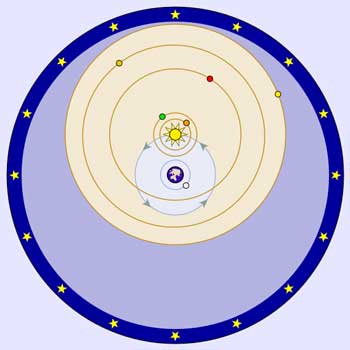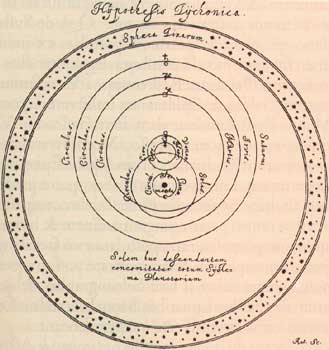The Tychonic system (or Tychonian system) was an effort by Tycho Brahe to create a model of the solar system which would combine what he saw as the mathematical benefits of the Copernican system with the philosophical and "physical" benefits of the Ptolemaic system. It is essentially a geocentric model (with the Earth at the center of the universe), around which revolves the Sun, and around the Sun revolve the other planets. It can be shown through a geometric argument that the motions of the planets and the Sun relative to the Earth in the Tychonic system are equivalent to the motions in the Copernican system, and the Tychonic system has the advantage of not predicting stellar parallax, which was not observable until the 19th century.

The Tychonic system shown in colour, with the objects that rotate around the Earth shown on blue orbits, and the objects that rotate around the Sun shown on orange orbits. Around all is a sphere of stars, which rotates.
Tycho argued that if the Earth were in motion, then nearby stars should appear to shift their positions with respect to more distant stars. In fact, this effect of parallax does exist, but it is too small to be observed with the naked eye, and even with the telescopes of the next two hundred years could not observe it, because even the nearest stars are far, far more distant than most astronomers of the time believed possible.
A further consideration for Tycho and his followers was biblical scripture. Some passages seem to assume that the Sun moves or the Earth is stable, and Tycho believed these statements should be interpreted literally.
Tycho's system was foreshadowed, in part, by that of Martianus Capella, who described a system in which Mercury and Venus are placed on epicycles around the Sun, which circles the Earth. Nicolaus Copernicus, who cited Capella's theory, even mentioned the possibility of an extension in which the other three known planets would also circle the Sun.
The Tychonic system became a major competitor with the Copernican system as an alternative to the Ptolemaic. After Galileo's observation of the phases of Venus in 1610, most cosmological controversy then settled on variations of the Tychonic and Copernican systems. In a number of ways, the Tychonic system proved philosophically more intuitive than the Copernican system, as it reinforced commonsense notions of how the Sun and the planets are mobile while the Earth is not. Additionally, a Copernican system would suggest the ability to observe stellar parallax, which could not be observed until the 19th century. On the other hand, because of the intersecting deferents of Mars and the Sun (see diagram), it went against the Ptolemaic and Aristotelian notion that the planets were placed within nested spheres. Tycho and his followers revived the ancient Stoic philosophy instead, since it used fluid heavens which could accommodate intersecting circles.
After Tycho's death, Johannes Kepler used the observations of Tycho himself to demonstrate that the orbits of the planets are ellipses and not circles, creating the modified Copernican system that ultimately displaced both the Tychonic and Ptolemaic systems. However, the Tychonic system was very influential in the late 16th and 17th centuries. After the Galileo affair, which transpired early in the 17th century, Copernicanism was officially forbidden to astronomers in the Roman Catholic Church; the Tychonic system was a religiously acceptable alternative that matched available observations. Jesuit astronomers in China used it extensively, as did a number of European scholars.

A 17th century illustration of the Hypothesis Tychonica from Hevelius' Selenographia, 1647 page 163, whereby the Sun, Moon, and sphere of stars orbit the Earth, while the five known planets (Mercury, Venus, Mars, Jupiter, and Saturn) orbit the Sun.
The discovery of stellar aberration in the early 18th century by James Bradley established that the Earth did in fact move around the Sun, after which Tycho's system fell out of use among scientists. In the modern era, the few who still subscribe to geocentrism use a Tychonic system with elliptical orbits.
In the modern era, the few who still subscribe to geocentrism use a Tychonic system with elliptical orbits
References: Owen Gingerich, The Book Nobody Read: Chasing the Revolutions of Nicolaus Copernicus, Penguin, ISBN-10: 0143034766
Retrieved from "http://en.wikipedia.org/"
All text is available under the terms of the GNU Free Documentation License

 Disclaimer
Disclaimer  Privacy Policy
Privacy Policy